Introduction
Creating a personal sanctuary for immersive entertainment is no longer a luxury reserved for sprawling homes with dedicated theater wings. As modern living spaces shrink, the art of designing functional and aesthetic small home theater rooms has gained prominence. Whether you’re a movie enthusiast, a binge-watching aficionado, or simply someone who loves unwinding with a blockbuster, having a tailored home theater can elevate your viewing experience to unparalleled heights.
However, achieving this dream in a compact space requires ingenuity. From navigating spatial constraints to ensuring superior audio-visual performance, the journey can seem daunting. The good news is that with the right strategies, even the coziest of rooms can transform into a cinematic haven that blends comfort, style, and technology seamlessly.
In this guide, we will explore innovative design ideas and practical tips that cater to spaces of all shapes and sizes. Whether you’re working with a nook in your living room, a corner of your bedroom, or an underutilized attic, this article is your blueprint for creating the ultimate small home theater. Prepare to turn any corner of your home into a captivating retreat where the magic of the big screen comes alive.
Table of Contents
Understanding the Basics of Small Home Theater Design
small home theater room design ideas : Designing a small home theater involves more than simply arranging a screen and a few chairs. It requires a deep understanding of how spatial dynamics, technology, and user preferences come together to create an immersive experience. In compact spaces, every design element must serve a purpose, ensuring functionality while enhancing aesthetic appeal.
Key Elements of a Functional Home Theater
At its core, a home theater is designed to replicate the cinematic experience. The primary components include a high-quality display, a powerful sound system, and comfortable seating. In small spaces, it’s essential to choose elements that fit proportionally to the room’s dimensions. Opt for flat-panel OLED or LED TVs, or consider a short-throw projector that can deliver large images without requiring substantial distance.
Sound is equally critical. Compact soundbars with subwoofers or satellite speakers provide an enveloping audio experience without overwhelming the space. Additionally, ensure seating arrangements offer unobstructed views of the screen while maximizing comfort, even in limited square footage.
Space-Saving Technology and Equipment Options
The technological advancements in home theater equipment have made it easier to achieve big performance in small spaces. Wall-mounted screens and speakers help preserve floor space, while wireless systems reduce cable clutter. Consider investing in multi-functional furniture, like ottomans with hidden storage or reclining chairs with integrated cup holders, to maintain both convenience and organization.
For those with extremely tight quarters, all-in-one systems combine screens, speakers, and streaming capabilities in a single unit, reducing the need for multiple components.
Planning for Acoustics in Limited Spaces
Acoustic planning is often overlooked in small home theater design, yet it plays a crucial role in delivering a rich auditory experience. Compact rooms can amplify sound reflections, leading to distortion. To counteract this, use sound-absorbing materials like acoustic panels, thick curtains, or plush rugs.
Strategically placing speakers ensures balanced sound distribution. Place subwoofers near walls to enhance bass and consider positioning smaller speakers at ear level for optimal clarity. If space allows, add bass traps in corners to manage low-frequency sound waves effectively.
Understanding these foundational elements sets the stage for creating a home theater that maximizes both function and style. With careful planning, even the smallest spaces can be transformed into a cinematic retreat.
Choosing the Right Location for Your Home Theater
The location of your home theater is a cornerstone of its success. Even the most state-of-the-art equipment can underperform if the chosen space doesn’t complement the design and functionality of a theater. Identifying the ideal spot in your home involves considering spatial dynamics, natural light, and the potential for creating a cozy yet immersive environment.
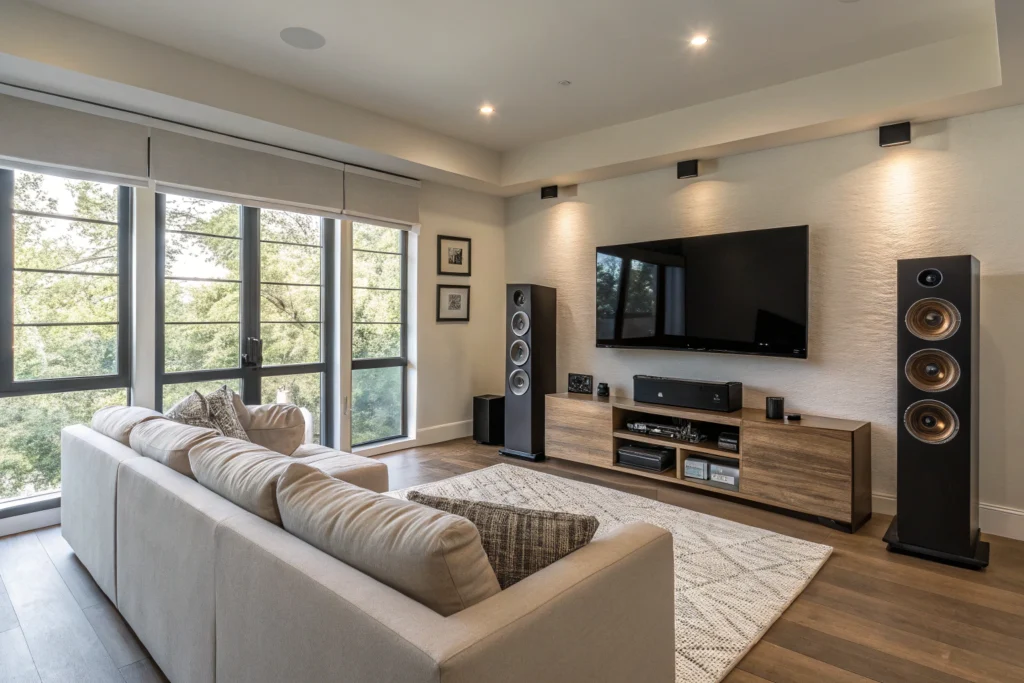
Best Spots in Your Home for Small Theater Setups
When selecting a location, the primary goal is to minimize external distractions while optimizing the acoustics and visual appeal of the space. Basements often rank high on the list of ideal locations. Their below-ground position naturally buffers sound and blocks out light, creating a cinema-like ambiance.
If a basement isn’t available, spare bedrooms or dens are excellent alternatives. These enclosed spaces can be easily adapted for a theater setup by adding blackout curtains and soundproofing materials. Even living rooms can double as home theaters with the right design strategies, especially if you incorporate versatile furniture and décor to maintain a dual-purpose aesthetic.
Transforming Unused Spaces: Basements, Attics, and Spare Rooms
Some of the best home theaters are crafted from spaces often overlooked. Basements, as mentioned, provide a quiet, enclosed environment, but attics are equally promising. While attics may require additional insulation and ventilation to maintain comfort, their sloped ceilings can add architectural interest and enhance acoustics.
Spare rooms, regardless of their size, offer endless possibilities for personalization. Even a walk-in closet can become a mini home theater with clever space utilization, such as wall-mounted screens and foldable seating. These unconventional spaces bring an element of creativity and uniqueness to the design.
Adapting Open Living Areas for Theater Functionality
Open-concept living areas may not initially seem ideal for a home theater, but with thoughtful planning, they can become multifunctional entertainment hubs. Dividing the space with bookshelves, curtains, or folding screens can help create a sense of separation and intimacy.
Strategically place the screen in a way that minimizes glare from windows or lighting fixtures. Soundproofing can be achieved using area rugs, fabric wall hangings, and heavy drapes. Additionally, choosing furniture that doubles as storage ensures the area remains uncluttered and inviting.
The right location lays the foundation for a home theater that seamlessly blends performance with comfort. Whether repurposing an underutilized room or optimizing an open space, a carefully chosen spot can turn any corner of your home into a cinematic haven. By balancing practical considerations with creative solutions, you’ll set the stage for unforgettable movie nights in the comfort of your own home.
Optimizing Layouts for Small Home Theaters
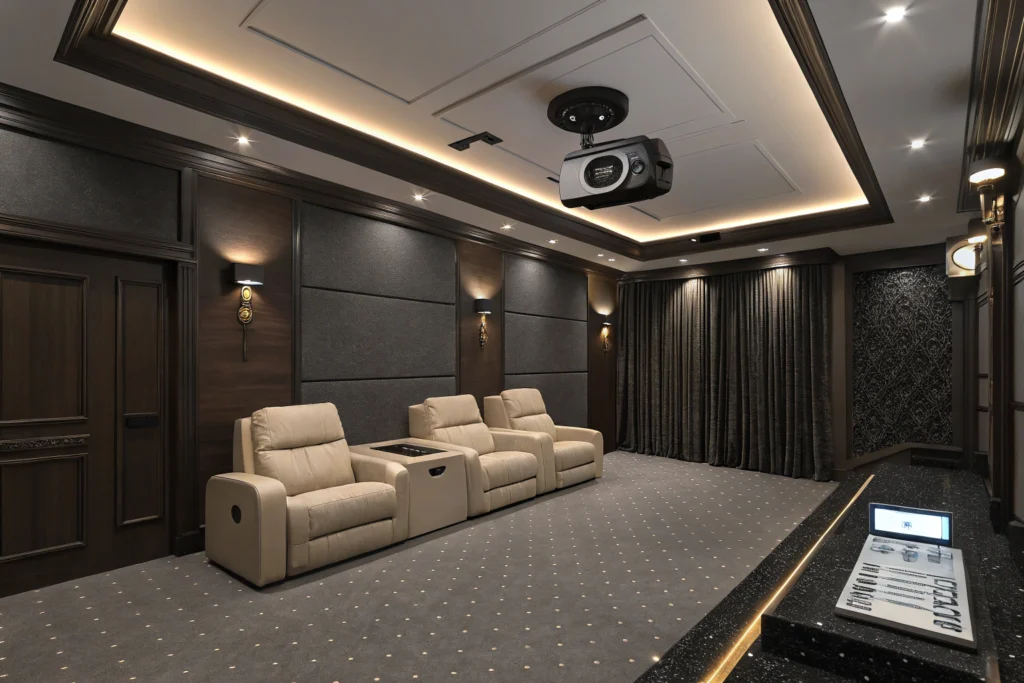
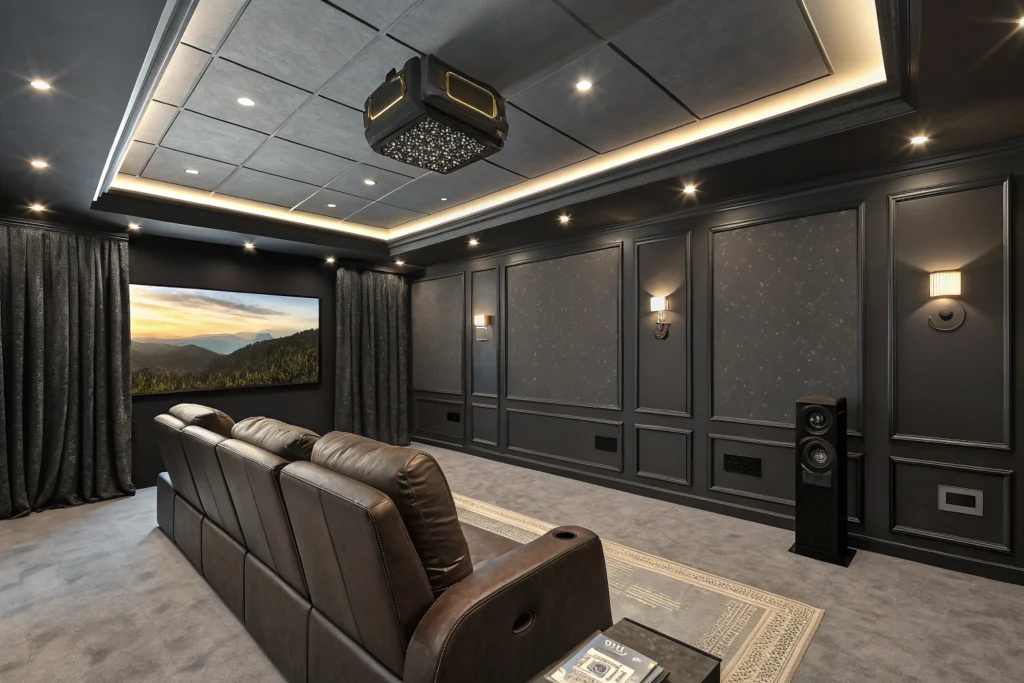
Designing a small home theater requires a strategic approach to layout optimization. The goal is to create a space that maximizes comfort and functionality without compromising the immersive viewing experience. Every square foot must be used wisely, blending practicality with design ingenuity to make the most of limited dimensions.
Creative Seating Arrangements for Limited Space
Seating is the heart of any home theater. In small spaces, traditional rows of recliners may not be feasible, but this opens the door to more innovative seating solutions. Consider multi-functional furniture such as sectional sofas with built-in storage or wall-hugger recliners that require minimal clearance.
For truly tight spaces, tiered seating can be achieved with platforms or risers, creating an authentic theater feel. Bean bags, floor cushions, or even lounge chairs can provide additional seating without overwhelming the room. Arrange seating to ensure everyone has a clear line of sight to the screen, prioritizing both comfort and accessibility.
Screen Placement for Maximum Viewing Comfort
Screen placement is a critical factor in optimizing a small home theater layout. Positioning the screen at the appropriate height is essential for reducing neck strain and ensuring a cinematic experience. Ideally, the center of the screen should align with the eye level of the seated audience.
For wall-mounted screens, consider using a tilting or articulating mount that allows for angle adjustments. If you’re using a projector, ensure the projection screen is free from obstructions and has adequate distance to provide a clear, vibrant image. Compact spaces benefit from short-throw projectors, which can produce large images from minimal distances, saving valuable room.
Balancing Functionality and Aesthetics
A well-optimized layout is not just about functionality; it also needs to look cohesive and inviting. Keep the design clean and uncluttered by utilizing smart storage solutions. Floating shelves or built-in cabinets can house equipment, media, and decorative elements without encroaching on floor space.
Lighting plays a dual role in functionality and aesthetics. Install dimmable lights or LED strips to set the mood while preventing glare on the screen. Recessed lighting and wall sconces can add depth to the room without taking up physical space. When choosing decor, opt for muted tones or dark colors to reduce reflections and maintain a theater-like ambiance.
Incorporating Practical Pathways
Even in a small home theater, it’s essential to consider pathways for easy movement. Avoid cramming too much furniture or equipment into the space, as this can make the room feel cramped and uncomfortable. Ensure there’s enough clearance between seats and other fixtures to allow effortless navigation.
Use rugs or carpet tiles to define pathways subtly while adding a layer of acoustic insulation. This enhances the auditory experience by minimizing sound reverberation.
Enhancing Versatility in Small Spaces
Sometimes, a small home theater may need to serve multiple purposes, such as a guest room or a family lounge. In these cases, optimizing the layout for versatility becomes crucial. Foldable or stackable seating, collapsible tables, and modular decor elements allow the room to transform seamlessly between uses.
Consider installing blackout blinds or curtains to control light when the room is in theater mode, while still allowing it to function as a bright, open space during the day.
Optimizing layouts for small home theaters is both a science and an art. By focusing on seating arrangements, screen placement, and multifunctional design, you can create a space that feels expansive, even within compact dimensions. With a blend of creativity and practicality, your home theater can deliver the immersive cinematic experience you desire, tailored perfectly to the constraints of your space.
Designing for Ambiance and Comfort
Creating a small home theater isn’t just about technical precision; it’s about setting the mood. Ambiance and comfort are the soul of any great theater room. These elements transform a functional setup into a cozy retreat where viewers can escape into cinematic worlds. Designing for ambiance and comfort means balancing visual appeal, auditory excellence, and physical relaxation.
Using Lighting to Enhance the Theater Experience
Lighting is one of the most influential factors in setting the tone for a home theater. The right lighting not only improves visibility but also elevates the overall ambiance of the room. Avoid harsh, overhead lights that can detract from the cinematic atmosphere. Instead, opt for soft, indirect lighting to create a more immersive environment.
Recessed lighting, LED strips, and wall sconces are ideal options for small spaces. These fixtures can be dimmed to complement the mood of the film. For a dramatic touch, consider installing color-changing LED lights that can shift hues based on the scene or genre of the movie. Under-seat lighting or floor-level LED strips can also add subtle elegance while guiding movement in a darkened room.
Soundproofing Tips to Maintain Privacy and Audio Quality
Soundproofing is essential for both comfort and immersion. Unwanted noise from outside can break the spell of an intense movie moment, while loud audio from your theater might disturb others in your home. To maintain privacy and optimize sound quality, invest in soundproofing materials.
Acoustic panels, available in various designs, not only absorb sound but can also serve as decorative elements. Thick curtains or drapes, especially blackout varieties, help dampen sound while blocking light. For floors, consider adding plush carpets or sound-dampening rugs that minimize echoes. If budget allows, insulated drywall or specialized soundproof paint can further enhance the room’s acoustic integrity.
Incorporating Cozy and Stylish Decor Elements
Comfort doesn’t stop at seating; it extends to every detail of the decor. Select soft, tactile materials such as velvet or chenille for upholstery, adding a sense of luxury to the space. Accent pillows and throw blankets in complementary colors create a warm and inviting vibe.
For the walls, choose darker tones to reduce screen glare and intensify the cinematic feel. Textured wallpapers or panels can add depth and interest without overwhelming the space. Incorporate art or memorabilia that resonates with the theme of movies or your personal taste, but keep it minimal to avoid cluttering the room.
Prioritizing Ergonomic Comfort
While ambiance creates the mood, physical comfort ensures you can enjoy hours of uninterrupted entertainment. Invest in ergonomic seating designed for extended use, such as recliners with adjustable footrests and lumbar support. If the space allows, add a few oversized floor cushions or bean bags to cater to different preferences.
For added convenience, include small tables or built-in cupholders for snacks and drinks. Armrests with hidden compartments can offer a discreet storage solution for remotes, charging cables, or movie cases.
Adding Subtle Aromatic Enhancements
Though often overlooked, scent can play a significant role in enhancing the overall theater experience. A lightly scented candle, an essential oil diffuser, or a subtle air freshener can help create a pleasant atmosphere. Choose calming scents like vanilla, cedarwood, or lavender that won’t overpower the senses.
Maintaining a Balanced Environment
To ensure lasting comfort, maintain a balanced environment in terms of temperature and air quality. Compact spaces can become stuffy during long movie sessions. A quiet air purifier or fan can keep the air fresh without disrupting the sound. For temperature control, consider portable heaters or cooling units, particularly if the theater is in a basement or attic where temperatures fluctuate.
Designing for ambiance and comfort elevates a small home theater from a functional space to a personal sanctuary. Through thoughtful lighting, effective soundproofing, and ergonomic choices, you can create an environment that feels both luxurious and intimate. By paying attention to the smallest details, your home theater becomes more than just a place to watch movies—it becomes a space to relax, unwind, and immerse yourself in the magic of cinema.
Maximizing Technology in Small Spaces
Technology is the backbone of any home theater. In small spaces, it’s essential to maximize the use of technology while keeping the setup streamlined and functional. By carefully selecting devices and integrating smart solutions, you can achieve a theater-grade experience without overwhelming the room.
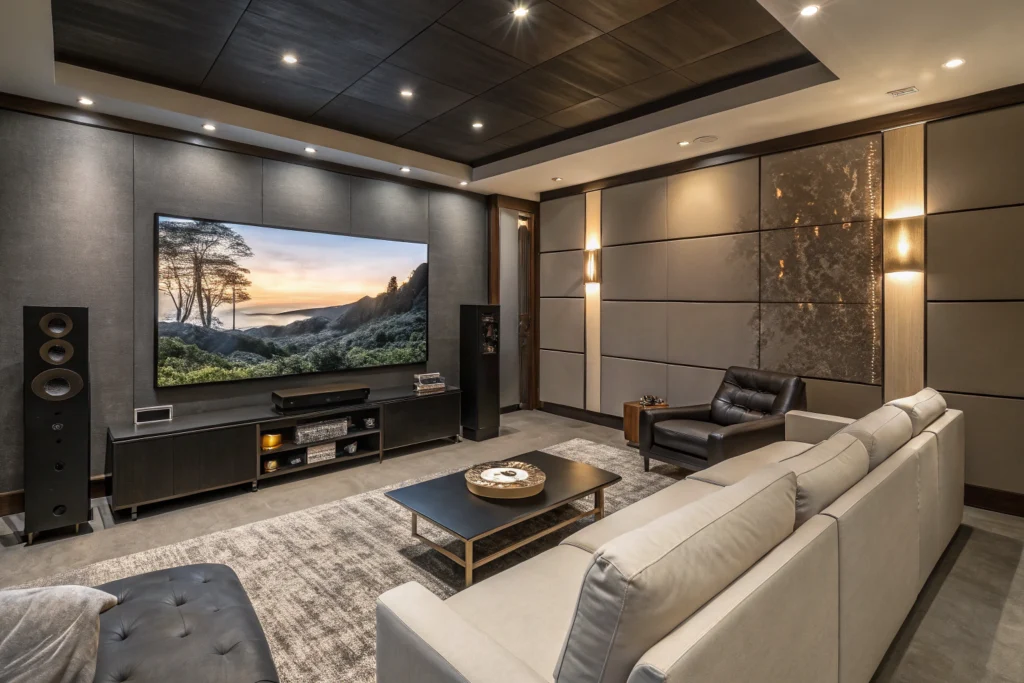
Choosing Compact and High-Performance Audio-Visual Equipment
Small spaces demand technology that is both space-efficient and powerful. Instead of bulky television units, consider ultra-thin OLED or QLED screens that deliver stunning picture quality while occupying minimal space. For those who prefer projectors, short-throw or ultra-short-throw projectors are ideal for compact rooms, as they can produce large images from a short distance.
Audio equipment also requires a careful approach. Traditional surround sound systems may be too cumbersome for a small theater, but soundbars with integrated subwoofers can offer impressive, room-filling audio. Wireless speakers and ceiling-mounted options can further save space without sacrificing sound quality.
Embracing Smart Home Integration for Seamless Control
Smart technology can transform a small home theater into a modern marvel. Integrate your devices with a central smart home system to control lighting, sound, and screen settings with a single touch or voice command. Platforms like Alexa, Google Assistant, or Apple HomeKit can streamline the user experience.
Smart remotes and apps eliminate the need for multiple controllers, reducing clutter. You can also set up automated scenes where, for example, dimming the lights and powering up the projector happens simultaneously. This creates a seamless transition into your movie-watching experience.
Optimizing Connectivity and Cable Management
In small spaces, cable clutter can quickly detract from the room’s aesthetic and functionality. Use wireless technology wherever possible, including Wi-Fi-enabled projectors and Bluetooth audio systems. For essential cables, invest in cable management solutions such as wall-mounted conduits, raceways, or adhesive clips to keep everything organized and out of sight.
If your devices require high-speed internet for streaming, consider using a mesh Wi-Fi system to ensure consistent connectivity throughout the room. Compact spaces with many electronics can be prone to signal interference, so proper network planning is crucial.
Leveraging Multi-Functional Devices
Incorporating multi-functional technology is an excellent way to conserve space while enhancing functionality. Many streaming devices, like Roku or Amazon Fire Stick, offer access to multiple platforms in a compact design. Gaming consoles can double as streaming hubs and Blu-ray players, reducing the need for separate devices.
All-in-one sound systems or integrated receivers simplify audio management, combining the features of multiple components into a single unit. This approach not only saves physical space but also minimizes setup complexity.
Exploring Advanced Display Options for Small Rooms
To maximize the cinematic experience in a small home theater, consider advanced display technologies tailored for compact spaces. Laser TVs, a hybrid between projectors and traditional screens, offer ultra-large displays with minimal hardware footprint. Similarly, microLED panels deliver unparalleled brightness and color accuracy while being slim and adaptable.
For those who prefer versatility, rollable or foldable screens are innovative options that disappear when not in use, freeing up valuable space. Pair these with ambient light-rejecting screen materials to ensure crisp visuals even in non-darkened environments.
Future-Proofing Your Setup with Scalable Technology
As technology evolves, it’s wise to invest in scalable systems that can grow with your needs. Choose equipment that supports firmware updates and new standards like 8K resolution or Dolby Atmos sound. Modular systems allow you to add components over time without requiring a complete overhaul.
By staying ahead of the curve, your small home theater will remain state-of-the-art, offering a cutting-edge experience without frequent replacements.
Maximizing technology in small spaces is an art that blends innovation with practicality. From compact devices to smart integrations, every element should contribute to a seamless and immersive viewing experience. With the right choices, even the smallest home theater can rival the ambiance and performance of larger setups, proving that size is no barrier to excellence.
Budget-Friendly Design Ideas
Creating a home theater on a budget doesn’t mean compromising on quality or style. With some thoughtful planning, resourceful shopping, and a touch of creativity, you can design a small theater space that delivers an exceptional cinematic experience without breaking the bank.
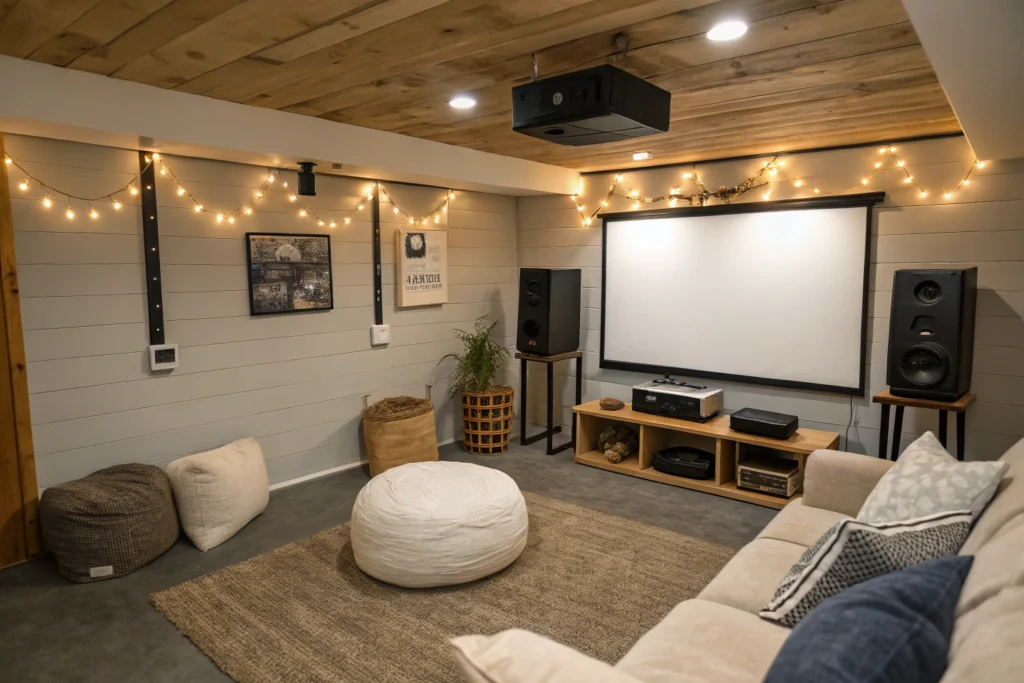
Repurposing Existing Furniture for a Theater Setup
You don’t need to splurge on new furniture to achieve the look and feel of a home theater. Repurposing existing furniture can be both cost-effective and eco-friendly. A sturdy bookshelf can double as a media console, while a comfortable couch or armchair can serve as seating. Enhance the furniture with affordable accessories like plush cushions or slipcovers to give them a refreshed look.
Coffee tables and end tables can be repurposed as snack stands or remote holders, ensuring practicality and convenience. Look around your home for unused furniture pieces that can be transformed with minimal effort.
DIY Solutions for Acoustic Treatment
Professional-grade acoustic panels can be expensive, but DIY alternatives can achieve similar results at a fraction of the cost. Use thick blankets, rugs, or curtains to absorb sound and reduce echoes. For a polished look, consider creating your own acoustic panels using wooden frames, insulation materials, and fabric covers.
Bookshelves filled with books can also act as natural sound absorbers while adding aesthetic appeal to the room. Focus on covering reflective surfaces, like walls and ceilings, to improve audio quality without spending excessively.
Finding Affordable Audio-Visual Equipment
High-quality audio-visual equipment doesn’t have to come with a premium price tag. Start by exploring refurbished or gently used options from reputable retailers or online marketplaces. Many brands offer budget-friendly lines of projectors, soundbars, and speakers that deliver excellent performance.
Streaming devices like Roku, Chromecast, or Amazon Fire Stick are cost-effective alternatives to high-end media players. Pair these with free or subscription-based streaming services to access a vast library of movies and shows.
Utilizing Creative Lighting on a Budget
Lighting can dramatically transform the ambiance of your home theater without requiring a significant investment. LED strip lights are affordable, energy-efficient, and versatile, allowing you to highlight edges or create a glowing effect behind screens. Battery-operated puck lights or fairy lights can add a soft, cinematic touch.
For an even cheaper option, recycle old lamps and replace their bulbs with dimmable LEDs. Pair them with colored filters or covers to create dynamic lighting effects that suit your theater’s theme.
Shopping Smart for Decor and Accessories
Decor doesn’t have to be extravagant to make an impact. Thrift stores, garage sales, and online marketplaces are excellent places to find unique and affordable items like framed posters, throw pillows, or vintage movie memorabilia. Look for multi-purpose items that combine functionality and style, such as storage ottomans or decorative baskets.
Wall decals and removable wallpaper can add character to your theater without the commitment or cost of permanent alterations. Focus on small touches that contribute to the overall theme, making your space feel cohesive and inviting.
Maximizing Comfort with Budget-Friendly Additions
Comfort is key to an enjoyable home theater experience, and it can be achieved without spending a fortune. Add inexpensive throws and cushions to your seating for extra coziness. Floor cushions or bean bags are budget-friendly seating options that work well for small spaces.
To maintain a consistent temperature in your theater, consider using heavy curtains or draft stoppers, which are both economical and effective at insulating the room. A small, quiet fan or heater can also keep the environment comfortable year-round without costing much.
Creating a High-Quality Experience on a Low Budget
The essence of a home theater lies in the experience it offers. Small details, such as organizing cables, arranging furniture for optimal viewing, and setting up a dedicated snack corner, can elevate your setup without significant expenses. Focus on creating an inviting atmosphere where you can relax and enjoy your favorite films.
A home theater doesn’t have to be lavish to be impressive. By prioritizing creativity and resourcefulness, you can achieve a design that rivals high-end setups while staying within budget.
Designing a budget-friendly home theater is about making smart choices and embracing ingenuity. Whether repurposing furniture, crafting DIY solutions, or shopping smart for equipment, there are countless ways to build a theater room that feels luxurious and functional. With a little effort and imagination, you can enjoy the magic of the big screen right in your home, all while staying financially savvy.
Final Touches and Maintenance Tips
Once the main elements of your home theater are set up, it’s time to focus on the finishing touches and ensure that everything runs smoothly for the long term. These final steps enhance the atmosphere, functionality, and longevity of your theater space. Additionally, regular maintenance ensures that your equipment and design remain in optimal condition.
Adding Personal Style and Decorative Elements
The final design details are where you can truly personalize your home theater. While technology takes center stage, subtle décor elements can elevate the experience. Begin with wall art or framed movie posters that reflect your favorite genres or films. Choose frames that match the color scheme or theme of your room, creating a cohesive look.
For a more unique touch, consider custom-made accessories, like throw blankets or pillows with movie-related designs. Vintage or thematic décor items, such as classic popcorn machines, film reels, or theater-style curtains, can add a nostalgic flair to the space. Remember, balance is key—avoid overcrowding the room with excessive decorations. The goal is to maintain a stylish, uncluttered atmosphere that complements the media experience.
Setting Up Proper Cable Management
Cable management is essential for both aesthetics and functionality. Unruly cables not only detract from the appearance of your home theater but can also pose safety hazards. Start by utilizing cable organizers such as clips, ties, and raceways to group cables together and keep them off the floor.
Consider wall-mounted solutions to hide cables running from your TV or projector to other devices. If using a projector, invest in a ceiling mount that can conceal wires effectively, creating a clean and seamless look. Don’t forget about power strips—select ones with built-in surge protection to safeguard your equipment from electrical surges.
Choosing the Right Seating for Comfort and Functionality
Comfortable seating is crucial for an immersive viewing experience. If you haven’t already addressed seating during the setup phase, consider adding ergonomic lounge chairs, recliners, or even modular seating that allows you to adjust configurations as needed.
Opt for furniture with built-in storage options to keep remote controls, game controllers, or DVDs out of sight yet easily accessible. If you’re working with limited space, multipurpose seating like foldable chairs or stools can be stored away when not in use. Always prioritize comfort—after all, a home theater is meant to be a place where you can relax and enjoy long viewing sessions.
Optimizing Lighting for a Cinematic Experience
Lighting can make or break the ambiance of your home theater. Adjustable lighting is key to creating the perfect environment for movie nights. Avoid harsh overhead lighting that can compete with the screen. Instead, opt for dimmable floor lamps, wall sconces, or LED strip lights that allow you to adjust the brightness as needed.
To enhance the cinematic experience, install accent lighting behind the screen or around the edges of the room. This reduces glare, improves contrast, and prevents eye strain during long viewing sessions. Consider smart lighting systems that automatically adjust according to the time of day or the type of media being watched.
Regular Maintenance for Longevity and Performance
A home theater requires routine maintenance to ensure that your equipment continues to perform at its best. Start by regularly cleaning your TV or projector screens to prevent dust buildup, which can impact image quality. Use microfiber cloths and cleaning solutions designed for electronics to avoid scratches or damage.
For projectors, clean the lens frequently and replace the bulb when it begins to dim or loses its clarity. Check your audio system regularly—dust and dirt can affect speaker performance, so use a soft cloth to wipe them down and ensure they’re free of debris.
Additionally, ensure that all connections—whether HDMI, USB, or Wi-Fi—are secure and working properly. Inspect cables for fraying or damage and replace them as needed. This prevents signal interruptions and helps maintain consistent audio and visual quality.
Protecting Your Equipment from Damage
Protecting your equipment from accidental damage is essential for prolonging its lifespan. Ensure that all devices are placed in well-ventilated areas to prevent overheating. Avoid placing electronics directly in front of air vents or windows, where they may be exposed to heat or sunlight.
To safeguard against electrical damage, use surge protectors for all equipment connected to power sources. If possible, invest in a whole-house surge protector for added protection against lightning strikes or power fluctuations. Regularly check your system’s components for signs of wear or malfunction, and address issues promptly to avoid more costly repairs.
Enhancing the Viewing Experience with Calibration
To truly elevate your home theater, proper calibration is a must. Adjust the brightness, contrast, and color settings on your television or projector to match the lighting conditions in your room. Many modern TVs and projectors come with pre-set modes (like movie or cinema mode), but you may want to fine-tune these settings for your preferences.
For audio, calibrate your sound system to ensure balanced, immersive sound. Many soundbars and receivers come with automatic calibration features that optimize sound levels based on your room’s acoustics. For more advanced setups, use a sound meter or hire a professional to calibrate your system to perfection.
The final touches and maintenance of your home theater setup are essential to preserving its quality and ensuring it remains a source of entertainment for years to come. Personalizing your space with décor, optimizing seating and lighting, and keeping your equipment in top condition through regular maintenance all contribute to creating a luxurious and functional viewing experience. By investing time and care into these finishing steps, you can enjoy an optimal, cinematic environment in the comfort of your own home.
Conclusion
Designing a small home theater is a rewarding project that combines creativity, practicality, and a touch of technology. From choosing the right location to optimizing the layout and integrating the best of both comfort and tech, every decision you make can enhance the immersive experience. While it’s easy to get caught up in the allure of high-end equipment and luxurious décor, the true value lies in creating a space that suits your personal preferences and lifestyle.
By focusing on essential elements such as acoustics, lighting, and layout, and making thoughtful design choices that balance functionality with aesthetics, even a small room can become a fully realized home theater. The process requires careful planning, resourceful thinking, and a focus on the details—whether it’s through budget-friendly DIY solutions, smart tech choices, or creating an ambiance that reflects your style.
The beauty of a home theater lies in its ability to bring people together, offering a space where friends and family can escape into films, sports events, and gaming adventures. As technology continues to evolve, there are always new ways to enhance your setup—whether through upgrading your audio-visual equipment, refining the acoustics, or optimizing the layout.
Ultimately, the key to a successful small home theater is ensuring that every element works in harmony to create a cohesive, enjoyable environment. With the right approach, your home theater will not only be a source of entertainment but also a sanctuary where you can relax and unwind. Embrace the journey of crafting the perfect space and enjoy the cinematic magic that unfolds right in the comfort of your own home.
